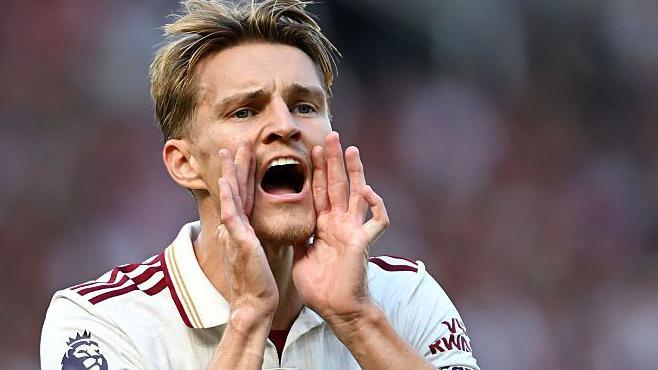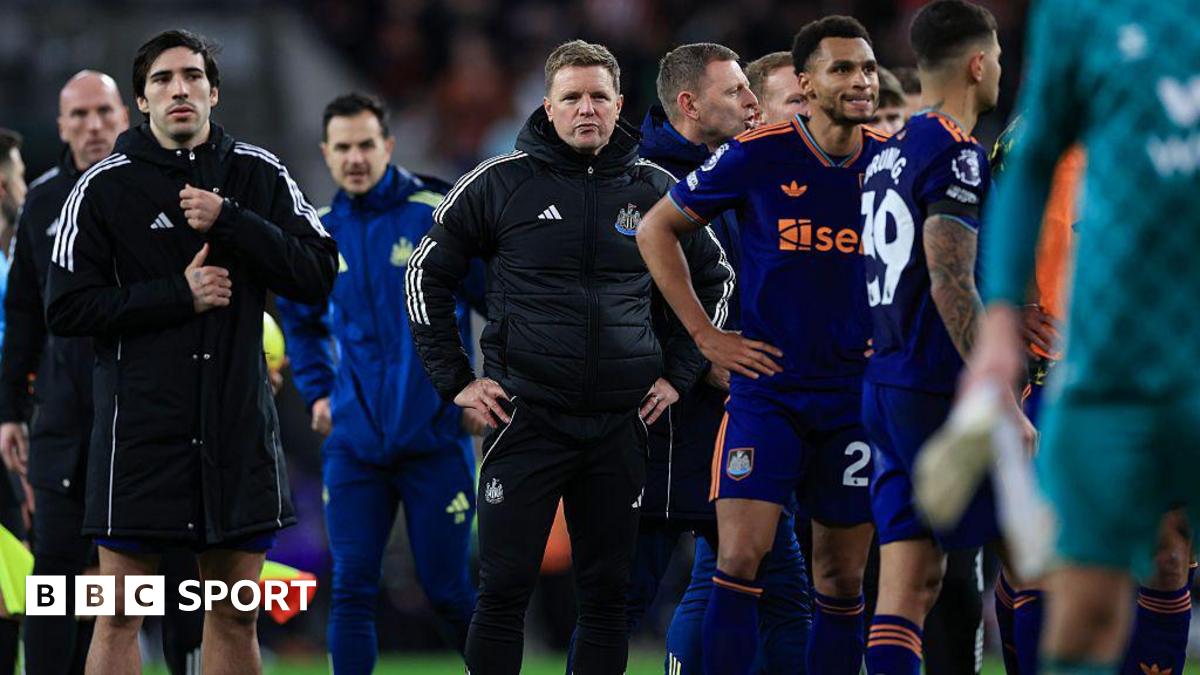 Image source, Getty Images
Image source, Getty Images
Arsenal have looked to introduce directness and counter-attacking threat, but how did their players adapt?
Umir Irfan
Football tactics correspondent
Chris Collinson
BBC Sport statistician
Another Premier league season has begun, with new-look sides, new-look tactical approaches and plenty of optimism (and pessimism!) among the fans.
We could have picked out many observations across all teams - but here are five that caught our eye in particular at the weekend.
1. Liverpool look weak against counter-attacks
Arne Slot's Liverpool have brought in attacking reinforcements but the balance of their side looks off. Against Bournemouth, they were bright going forward but looked susceptible to conceding on the break.
Last season, Liverpool only conceded two goals from fast breaks all season. In the first game of this season, they equalled that number.
So what has changed for Liverpool?
The personnel informs how tactics are executed and Slot pointed towards sloppy passing in midfield as a reason Liverpool were so exposed. These misplaced passes gave the opposition time and space against a disorganised defensive shape while attacking the centre of the pitch.
This is more dangerous than losing the ball in the wide areas as attackers are closer to goal, in better shooting positions.
Although Slot focuses mainly on the sloppy passing and dispossessions in midfield, it is objectively true that Liverpool committed many bodies to their attack. At times, there were seven or eight players in and around Bournemouth's box, leaving Liverpool with very few players back to defend.
For Antoine Semenyo's second goal, both Joe Gomez and Andy Robertson were attacking in the opposition's box so were unable to get back to defend the counter-attack when the ball was lost.
Yes, decision-making and passing quality needs to be better but Slot may need to tweak the positions of the full-backs or central midfielders when Liverpool are attacking for additional protection against dangerous counter-attacking sides.
 Image source, Premier League
Image source, Premier League
Salah's misplaced pass arrived at Semenyo (highlighted in red) before Bournemouth's counter-attacking goal. Note Liverpool's fullbacks in very attacking positions
2. Man City look like they are back
Many people consider Man City as outsiders in the title race – only five of our 33 pundits predict them lifting the trophy in May – but their impressive 4-0 win at Wolves means that they've now taken 43 points from their 20 games in 2025 - more than any other side.
Rodri's season-ending injury last September clearly derailed their Premier League campaign but rather than simply awaiting his return, Pep Guardiola has found a solution without him and the former champions have been getting back on track since the start of the year.
Below is Man City's 'non-penalty expected goal difference per game' (that's a mouthful) since the start of last season, which tells us how much a team dominates their games by creating lots of good chances and limiting their opponents to few, bad ones.
It's the X-ray stat, the one that shows how good teams are before hot finishing streaks and the rub of the green come into play.
As we can see, Man City are now almost dominating games to the level they were before the Ballon d'Or winner's injury.
Anyone writing them off does so at their peril.
3. Still no magic spark from Potter at West Ham
It's fair to say that Graham Potter has not had the impact many expected when he replaced Julen Lopetegui as West Ham manager in January, with the 3-0 defeat by Sunderland on Saturday their ninth defeat in 19 Premier League games under him.
In fact, he now needs to orchestrate a win over his former club Chelsea at home on Friday night simply to match Lopetegui's Premier League record before he was sacked after 20 games in charge.
Potter has noticeably improved the defence that he inherited, with the Hammers conceding 13 fewer goals and 69 fewer shots than they did under the Spaniard (although those stats will be slightly worse after the Chelsea game).
However, that defensive improvement has come at a significant cost to the attack. While they've only scored two goals fewer (with a game to play), West Ham's shot and expected goal numbers have deteriorated dramatically.
The big improvement in their goal difference would suggest they've perhaps been a bit unlucky in terms of results, but their xG difference shows that Potter has improved them only slightly overall and is yet to really work his magic on West Ham.
4. Frank's clever kick-off routine
Thomas Frank's Tottenham have adopted many of the same principles we saw work for Brentford last season and the novel use of dead-ball situations is one. Of particular note this weekend was the use of the kick-off as a set-piece routine.
Against Burnley, the ball was passed back to Guglielmo Vicario from kick-off as the home team shuffled up the pitch. Burnley logically shuffled deeper, pre-empting a long ball. The deceptive nature of how Vicario shaped up sold this routine further before a shorter pass to Pedro Porro was played.
By finding Porro towards the inner right side of the pitch, closer to goal, the angle he could play the cross at was more likely to result in a dangerous chance. Porro is one of Spurs' strongest crossers and with Spurs getting an extra body at the back post, on another occasion this may have resulted in an early goal.
By manufacturing a situation in which the ball is launched long early has the added benefit of getting the ball away from your own goal so pressure from the opposition can't be applied.
Frank's sides aim to maximise fine-margin gains across the pitch and the focus on a smart, well-worked kick-off routine is another tool in their expansive skillset. Across this season, they will certainly continue to experiment with their kick-off routines.
 Image source, Premier League
Image source, Premier League
By pretending to go long from the goalkeeper, Vicario was able to find Porro in space, in a more dangerous crossing area
5. Arsenal trying to be more direct: The Good, the Bad & the Ugly
Mikel Arteta's Arsenal have taken an alternative approach to their recent summer transfer business. For a team who have dominated the ball, playing slowly and methodically for the last few seasons, they have now looked to introduce directness and counter-attacking threat.
Against Manchester United, Arsenal played more directly and it was to their detriment on the day. We saw numerous quick attacks consisting of players carrying the ball quickly upfield over large distances before trying to play through balls for the attackers. In seasons gone by, they would've likely opted to hold the ball, passing it backwards before restarting their attack.
Martin Odegaard was primarily the player leading the majority of counter-attacks. Viktor Gyokeres' best attacking zones are in the inside right channel. As the Swede darted in behind, Odegaard's weight of pass was off and chances broke down. This made the game end-to-end, suiting United's quick attackers.
Odegaard being left footed here was slightly problematic too. Angle-wise, using a right-footed player would allow the pass to go towards the goal rather than curling away from it, making it easier for someone like Gyokeres to shoot early. Imagine Kevin de Bruyne's through balls (from right central midfield) to Erling Haaland if you're struggling to understand what I mean.
Although this style of play was ineffective in the opening game, there are positives. If Arsenal can get the final pass correct, they'll find themselves in clear goalscoring opportunities more often. How Arsenal balance their slower possession style with this newer, transitional quality will be an important thread to their season.
.png)
 3 months ago
13
3 months ago
13








 English (US) ·
English (US) ·